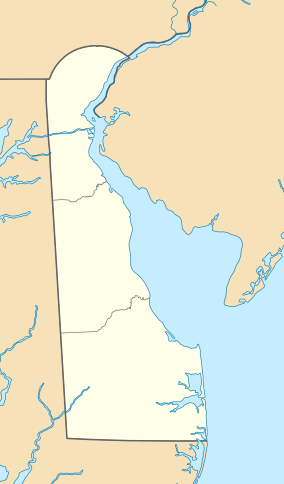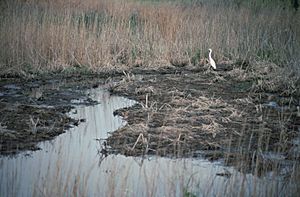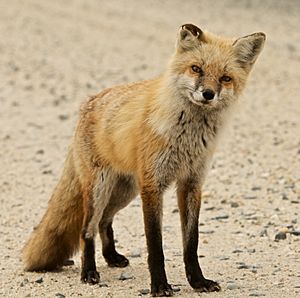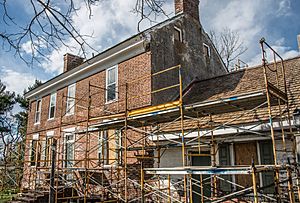Bombay Hook National Wildlife Refuge facts for kids
Quick facts for kids Bombay Hook National Wildlife Refuge |
|
|---|---|
|
IUCN Category IV (Habitat/Species Management Area)
|
|

Hundreds of thousands of ducks and geese arrive at Bombay Hook each year to rest
|
|
| Location | Kent County, Delaware, Delaware, United States |
| Area | 25 sq mi (65 km2) |
| Established | 1937 |
| Named for | Corruption of the Dutch "Boompjes" or "Boompjes Hoeck" meaning "little-tree point" |
| Visitors | Open daily |
| Website | Bombay Hook National Wildlife Refuge |
The Bombay Hook National Wildlife Refuge is a special place for wildlife. It covers about 15,978 acres (64.66 square kilometers). This refuge is located along the eastern coast of Kent County, Delaware, in the United States. It sits right on the Delaware Bay.
The refuge was created on March 16, 1937. Its main goal was to protect and provide a safe home for birds that travel long distances. These birds include ducks and geese that spend the winter here. They use a major bird highway called the Atlantic Flyway. The land for the refuge was bought using money from federal duck stamps.
Today, Bombay Hook protects many different kinds of wildlife. It especially focuses on all kinds of migratory birds. The refuge is also home to the Allee House. This old farmhouse was built before the American Revolutionary War. It is listed on the National Register of Historic Places. The refuge is also a stop on Delaware's Coastal Heritage Greenway.
Contents
History of Bombay Hook
The area now known as Bombay Hook has a long history. Native Americans called it Canaresse, which means "at the thickets." Later, the Dutch called it Ruyge-Bosje, meaning "shaggy bushes." The name Bombay Hook comes from a Dutch phrase, "Boompjes Hoeck." This means "little-tree point."
In 1679, a Native American chief named Mechacksett sold the Bombay Hook wetlands. He sold them to Peter Bayard, an early Dutch settler. The price included one gun, some gunpowder, three waistcoats, some liquor, and one kettle.
Early Developments
In 1682, a canal was built from the town of Smyrna to the Delaware Bay. This waterway became the Smyrna River. The Bombay Hook Lighthouse was built by the U.S. Government in 1831. It was later made automatic in 1912. Sadly, people burned the empty lighthouse in the early 1970s.
The Allee House is still standing on the refuge today. It was built in 1753 by Abraham Allee. He was a Huguenot refugee from France. The house is on the National Register of Historic Places. It looks almost exactly as it did when it was first built.
In 1848, a hotel was built on Bombay Hook Island. This made the island a popular vacation spot. By 1870, a steamboat called the Pilot Boy traveled regularly between Bombay Hook and Philadelphia.
The Great Tidal Wave
In 1878, a huge storm hit the area. Local people called it the "great tidal-wave." This storm destroyed summer resorts on Collins and Fraland Beach. It also changed the land at Bombay Hook. Before 1878, sand dunes protected the inner marshes from storms. But the storm broke through these dunes. They were never fixed, and you can still see the effects today.
Creating the Refuge
In 1937, about 12,000 acres (49 square kilometers) were bought. Most of this land was salt marsh along the Delaware Bay. This land was used to create the Bombay Hook Migratory Waterfowl Refuge. The money came from duck stamp sales.
On April 1, 1938, the Civilian Conservation Corps (CCC) started working at the refuge. They cleared wooded swamps. They also built dikes to create freshwater ponds. They planted over fifty thousand trees. The CCC built a headquarters building, an observation tower, and houses for staff. They also dug ditches to control mosquitoes. Their work ended in March 1942.
In 1939, the refuge's name was changed. It became the Bombay Hook National Wildlife Refuge.
Later Years and Growth
During World War II, the refuge was used for gunnery practice. It was also used for testing aerial rockets. In 1961, another freshwater pond, Bear Swamp Pool, was added. This made a total of 1,100 acres (4.5 square kilometers) of freshwater ponds. These ponds are carefully managed to help thousands of waterfowl and shorebirds.
In 1980, an Atlantic Beaked Whale got stuck at Bombay Hook.
In 1986, Bombay Hook NWR was featured in "World Safari." This was a satellite program by National Geographic, BBC, and Turner Broadcasting. The refuge was chosen because of its large number of snow geese.
In 2015, the Bombay Hook National Wildlife Refuge was honored on a special quarter. It was part of the America the Beautiful Quarters series. The quarter shows a great blue heron and a great egret in a salt marsh.
The refuge has grown since 1937. The last addition was in 1993. This brought the total area to 15,978 acres (64.66 square kilometers). Managing the refuge has helped many birds and other wildlife.
What the Land is Like
The salt marshes at Bombay Hook are very important for wildlife in Delaware. Large parts of the refuge are kept in a natural state. The marsh has many tidal streams and rivers. This provides a great home for birds and mammals. It also acts as a nursery for young marine animals.
The refuge carefully controls the water levels in its ponds. This helps grow plants that waterfowl like to eat. When the water levels are lowered, large areas of mudflats appear. Many shorebirds and wading birds come to feed on these mudflats.
Farmers also grow crops on about 1,100 acres (4.5 square kilometers) of land. These crops provide extra food for waterfowl and other birds.
Animals and Protected Species
The main goal of the refuge is to protect homes for waterfowl and other migratory birds. This includes the threatened bald eagle. Bombay Hook is a key resting spot for birds traveling along the Atlantic Flyway. Many ducks and geese arrive each fall to spend the winter or to rest before flying further south.
Delaware Bay is also the second largest gathering place for spring migratory shorebirds in North America. Almost 350 different kinds of birds have been seen at the refuge. This includes some rare visitors. As of 2009, eBird has recorded 302 species of birds here.
The different types of habitats in the refuge provide food and shelter for many other animals. Thirty-five different mammal species have been identified. You might see cottontail rabbits, woodchucks, gray squirrels, red foxes, and white-tailed deer. These are often seen in the early morning or late afternoon.
Other animals found here include salamanders, toads, frogs, turtles, lizards, and snakes. You might also spot beavers, muskrats, river otters, and opossums.
In 1990, different groups worked together to study horseshoe crabs. Volunteers surveyed Delaware Bay during their spawning season in May and June. After 10 years of watching, rules were put in place in 2000 to protect them.
Things to Do and See
Bombay Hook has many things for visitors to enjoy. There is a visitor center, a driving tour route, observation towers, and nature trails. You can go hiking, take photos, and watch wildlife. The Bear Swamp Trail and the visitor center are easy to use for visitors with disabilities.
You can drive a 12-mile (19 km) round-trip route to see wildlife. There are also five nature trails. They range from 1⁄4 to 1 mile (400 to 1600 meters) long. Three of these trails have 30-foot (10 meter) observation towers. These towers offer great views of the refuge.
Hunting is allowed for waterfowl and deer in certain areas. This is done under special rules during Delaware's hunting season.
The Allee House
The Allee House looks much like it did in the 1700s. It overlooks the fields and marshes of Kent County, Delaware. It is one of the best examples of an old brick farmhouse in Delaware. Abraham Allee built the house around 1753.
Abraham Allee was an important person in his time. He served in the Assembly and was a Justice of the Peace. The house has beautiful brickwork. Inside, the parlor has lovely wood paneling. The fireplace area has special panels and two hidden china closets. These closets have unique shelves and a fluted center post.
Over the last 40 years, the house's walls and support beams have been damaged by water. Because of safety concerns, tours of the Allee House have been stopped.
Old Lighthouses
Port Mahon Lighthouse
Port Mahon is at the southern edge of the refuge. It was named after a city on the Spanish island of Menorca. Around 1890, Port Mahon had a blacksmith shop and a general store. It was a busy port area. The lighthouse was built in 1903. The lighthouse keeper took care of the kerosene lamps. Supplies were brought in once a year by carts. Sadly, the lighthouse was destroyed by fire in 1984. Only its support poles remained.
Bombay Hook Lighthouse
The Bombay Hook Lighthouse was built by the U.S. Government in 1829. In 1830, former Governor of Delaware Jacob Stout planned the road between the lighthouse and Smyrna. In 1831, President Andrew Jackson appointed Duncan Stewart as the first keeper. When Duncan died in 1854 at age 92, his daughter Margaret became the keeper.
Four other keepers and their families lived and worked there. The last keeper was Edward W. Long, appointed in 1912. In September 1912, new automated lights were put in the Smyrna River. The Bombay Hook Lighthouse was no longer needed. It was abandoned and fell apart for decades. In 1974, the Delaware State Division of Fish & Wildlife decided to tear it down. It had become dangerous due to vandalism and fires.
Images for kids








